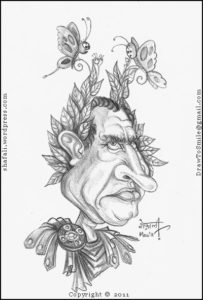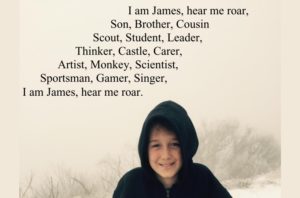This is Sterno Claudio Masticlese. He is a lesser known Roman General and the Patron Saint of the outer 4 rings of a standard World Archery Target. He was dysfunctional consort to Phoebe who gave name to the distant dust bands around Saturn. He is recognised by a rather large nasal apparatus and a small neck (that has a very flash medical name for the muscle group). Those who wish to progress in the field of Olympic Recurve Archery should walk away from his teachings and concentrate on a smooth energy flow in a developed release cycle that culminates in a smooth delivery from a clear and repeatable anchor point just below the jaw line adjacent the sternocleidomastoid.

RELEASE CYCLE FOR OLYMPIC RECURVE ARCHERY – THE ONLY PAGE YOU EVER NEED TO READ
Filling in the Gaps – There is a whole bunch written about the ten steps of the release cycle, but I don’t think that it is necessarily a complete or holistic story. So I will describe the 10 steps but add some sub steps to make it more applicable to the person standing on the line, rather than the person reading the book. The main concept I want to add is the ability to exit the release cycle if it is not right. This may not always be appropriate if you are in a timed contest, but you need to understand when you are out of cycle and correct or end that process.
Sport Art or Science – Now if you think that your new career in archery is a fast track to a successful sporting career you need to have a serious slow down and rethink your choices. I will pose here that archery is a very complex field that requires a multi – disciplined approach with sport only being a little part of the banquet. There is a health whack of science and whilst most of this is shown in equipment design, there is still a working knowledge of physics required on the line. Then there is an immense meal of eastern meditation philosophy needed. I will outline key points of breathing and awareness that link heavily to the ancient arts of meditation. But even modern archers talk of a level of awareness and some muscle memory to achieve success and these are largely, but not exclusively, grown from the asian subcontinent. I am not professing a course in meditation at any level, it is something I have tried and get little and sometimes a negative payback from but a working knowledge of the key principles is essential. I am sure many birthday party archery coaches don’t tell the birthday kid to breath and achieve focus, but I attest there would be significant improvement in the results and greater takeup of the sport from these introductory events. I suppose what I am dancing around is that Archery is an Art pretending as a sport with a heavy input of science. The best archers get this either consciously or at another level of awareness. You will also meet people who take it back to a primal level of a rather organic hunting discipline. I have no issue with this pursuit, but it is not the art of field archery. There is also other types of bows such as cross or compound. I suggest unless there is a medical reason for using these elite machines then it again is sideways to field archery. Long bow and bare bow users are also a subset of the sport, they generally have a sublime understanding of the sport as an artform and should be respected for mastering the simple.
Step zero EQUIPMENT – I am not going to drag sideways into choice of equipment but once you and you coach have selected all your equipment make sure it is ready to go before you start. Check all screws so as not to have a failure during your session and take everything you need over to the line. Leave all the other stuff well away, this includes phones and wallets and stuff unless they are part of your training tools. Food and drinks can be a distraction so ensure you have some water and essential energy snacks only. Start your warm up with appropriate stretches designed with your coach/Medical team. If you have guards and a quiver belt, get it all on and comfortable before going to the line. Attach appropriate Target to the butt at the required distance.
Step one STANCE – This is super important. It starts with the simplest thing od getting the right pair of shoes, doing them up correctly and doing this each time you shoot. Pick up your bow and select your stance, I find that a slightly open stance is better but there is much success from a closed or straight stance. Once you know where this ‘happy place’ is for your feet keep them there. Next thread and knock your arrow.
Step two FINGER PLACEMENT – Get your fingers comfortably and correctly around the string either side of the knocked arrow. At this stage, I have my bow generally pointing safely towards the ground for this. The next step is about Hand placement on the bow so I take the weight of the bow with my string hand and let it rest and even bounce a little, it stops me from grabbing the bow/riser to tight.
Step three HAND PLACEMENT – This now allows me to check the riser is aligned to the fleshy part of my bow hand. I make sure my shoulders are relaxed. The next step will work them and I need to have them at a neutral ready point. So I now take an appropriate grip of my bow to control it, but not strangle it. My shoulders are relaxed and I am aware of the alignment so I can move to the next step.
Step four BOW ARM – I can now raise my bow arm to a horizontal position. I keep just enough tension in the string arm to keep the bow under control. From here onwards I will start to fatigue in this outstretched arm so I need to move with some flow and momentum BUT if it is not going well, then this is a great exit point. I get my eyes up onto the target and my preference is to close one eye (discuss with your coach). This is the most appropriate point to ensure you Bow arm geometry is correct, if not, change or exit.
Step five DRAWING – I take a slow, deliberate breath in and draw my bow to full draw. If you are using a clicker then draw to the friction point of your clicker but not past.
Step six ANCHORING – At or near full draw anchor my string hand below my jawbone so as my thumb is into the depression in my neck or sternocleidomastoid muscle group. This anchor is essential to the aiming geometry so if you can’t feel it, lower and detention your bow.
Step seven HOLDING – I call this the check anchor point and then I breath out as I transition into my aim stage.
Step eight AIM – There is much written about the amount of time you can hold the aim position and the mental focus of the aim so again momentum and energy flow is essential hear. As I breath out, I am adjusting my aim to compensate for the body change in the exhalation. As my breath is emptying, this is the stillest my body can be for a few seconds until I start to draw breath in. This is the ideal point for best aim and execution of the cycle. I would suggest that only one or two breath cycles are able at full draw, maybe a third if you are very ‘bow fit’. If you can’t release in these breaths, you have to exit the cycle.
Step nine RELEASE and Step ten FOLLOW THROUGH – I have chosen to combine these steps as for me the follow through is more important than the release. That is a release without a follow through is most probably a fail; A well designed follow through will promote a great release. I work on a gentle contraction in my shoulder blades of the back and push my elbow back and this promotes a great release. I often think that paying a Dominant to whip me every time I fluff my follow through would be a more cost effective coaching session than the often high fees elite sportspeople charge for a moment in there company for a second hand set of advice.
Step eleven POST CYCLE ANALYSIS, SCORE AND ADJUST – If all went well this is a simple step, if something went away from the plan, then there may be some adjustment needed. Changes to equipment should only be a last resort after you have analysed all else. Sometimes you might need to adjust your gear and that is fine. As it is a cycle you need to get back up to step one and start again.
Now a closing statement on your coaches. I wrote a paper some years back on the modern fad of executive coaching and the link to sports coaching. I think we de-legitimise the profession by putting a very large umbrella over a series of very important but different series of roles. For example, a head coach in AFL will often say the work is done before the bounce with only a few tweeks in NFL they are a key decision maker in calling plays for the game. In soccer they are again in a spectator role with field position changes being a subordinate coach to manage. Executive coaches are more like a senior coaching role, they assemble a team of professionals to meet a goal. If you can access a great club coach then that will get you well on the road to managing and refining your cycle; but then you need to progress. This new person should be able to make comments on your cycle but also about equipment, exercise, mindset and even diet. If they are not providing this service then they are not a great coach regardless of sporting ability. A friend of mine is a true executive coach. He can think high level and mentor me to goal setting and formulate a path to execution. He can enlist other professionals to support the journey and he can seamlessly muck in and walk the walk with me. In any field coaches like this are rare and hidden like a Pokemon but you gotta catch one! I was asked by a colleague if marriage changes anything in life; I would offer that it doesn’t but there is plenty of material written to say it does. I would offer that it amplifies things. Stuff that is working well gets better and stuff that is niggling under the surface gets brought out big time. I think a coach is like that, don’t expect change, but certainly expect your good bits to get better and you bad stuff to be paraded in front of you at the club, it will be analysed and either remediated or become that misplaced snack you choke on in competition. Remember the coach is enlisted by you to do a job and you gotta let them do it.
Just a quick refresh on the release cycle now and a good summary for your field notebook. Feet, thread and knock, hands, bounce, shoulders, bow arm up, eyes up, breath and draw, anchor and check anchor, hold, aim and breath out, release to follow through, post cycle checks, adjust and score if needed.
That’s all from me for now, take care and chat soon.
